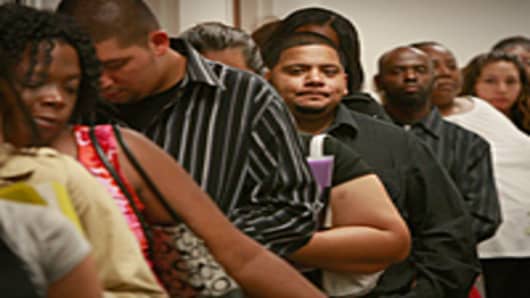The slow melt-up in employment continued during February as the economy added 227,000 new jobs while the unemployment rate held flat at 8.3 percent.
With warm weather helping to spur activity and as the European sovereign debt crisisreceded into the background, the American economic engine continued its steady drive toward recovery.
Economists had expected 210,000 net new jobs and the unemployment rate to hold steady at 8.3 percent.
Private payrolls in February grew by 233,000. Manufacturing added 31,000 jobs and services 203,000. Government subtracted 6,000 jobs from the total, according to the latest report from the Bureau of Labor Statistics.
Job creation fell short of the January totals, when the economy saw an upwardly revised 284,000 new jobs and a drop in the jobless rate.
"The good news is that the improved pace of job growth continued in January and February," said Kathy Bostjancic, director of macroeconomic analysis at the Conference Board. "The really good news is that this pace of job creation looks like it could be sustained through spring and summer, and possibly even pick up."
Reaction from the financial markets was muted — stocksedged higher at the open while Treasury yieldsrose.
Job gains were broad-based.
Professional and business services added 82,000, though more than half were temp jobs. Health care gained 61,000, while hospitality — primarily bars and restaurants — contributed 41,000 for the month, while the industry has added a total of 531,000 jobs over the past two years.
Though the construction trade was expected to benefit most from the unseasonably warm weather, employment in the industry actually fell by 13,000 for the month.
While the report offered plenty to support a sustained jobs recovery, the pace remains slow.
"We have 5.3 million fewer jobs now than we did before the recession started, and we should also have added around 4.6 million jobs over this period just to keep up with normal growth in the working-age population," said Heidi Shierholz, economist at the Economic Policy Institute. "Even at the quite strong average growth rate of the last three months (245,000 jobs added per month), it would take roughly five years to get back to full employment in the labor market."
An alternative measure of unemployment which does count those who have stopped looking for work dropped to 14.9 percent, its lowest reading since January 2009.
Long-term unemployment continues to pose the most vexing problem for the jobs picture. The average duration of unemployment edged lower but remains at 40 weeks. Those out of work for more than 27 weeks comprise 42.6 percent of the unemployed population.
"Overall the labor report is at least a positive step with key metrics heading in the right direction," said Andrew Wilkinson, chief economist strategist at Miller Tabak in New York. "The problem is, however, that there are few signs that the pace of growth is accelerating and while we might be in for a series of decent reports like this, the February data is the bare minimum necessary to help expedite recovery. At its worst, the Fed will still be disappointed with 'far from normal' conditions within the labor market."
Despite the upward trend in job creation, there remained strong doubts about whether the unemployment level could hold up.
The headline rate was at 9.2 percent as recently as June but has fallen since, benefited both by job creation and the Bureau of Labor Statistics' byzantine method of calculating the number.
Though the labor force participation rate actually increased to 63.7 percent in February, it remains near historic lows. Those not looking for jobs are simply not counted in the official jobless rate. The rate is thus treated with skepticism as an accurate gauge for measuring the job market's health.
Federal Reserve Chairman Ben Bernanke said in recent remarks to Congress that the current rate "no doubt understates the weakness in the labor market in some broad sense."
In fact, when adding the aging population and the decline in population rate against actual jobs created, the unemployment rate likely dropped just 0.04 percentage points since last August, according to an analysis from Nomura Securities economist Aichi Amemiya. According to the government's measure, though, the rate dropped 0.8 percentage points.




